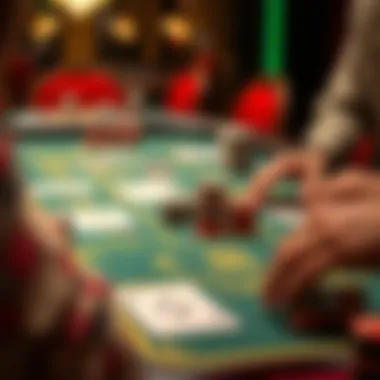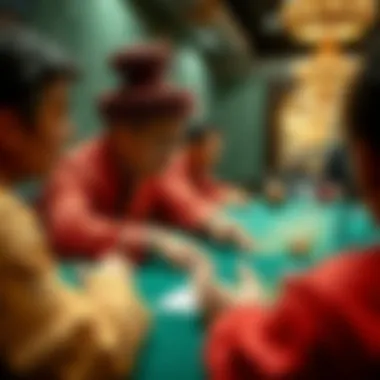Exploring the Rich History and Strategies of Pai Gow


Intro
Pai Gow is far more than just a game played in the glitzy casinos of Las Vegas; it’s a tapestry of history, strategy, and culture woven tightly into the fabric of American gambling. With origins tracing back to ancient China, this game has evolved into a unique experience that draws both novices and seasoned players alike. In the bustling atmosphere of Las Vegas, Pai Gow offers not only the thrill of betting but also a compelling social experience among players.
Here, we step into the nuanced world of Pai Gow, where each hand dealt carries with it a rich background and a wealth of strategies. Understanding the game’s intricacies — from its betting strategies to its various forms — can significantly enhance your gaming experience and perhaps even tilt the odds in your favor.
Betting Strategies
In any casino game, betting strategies play a crucial role in determining your outcome. Pai Gow is no exception. This section navigates through ways to maximize your potential and capitalize on the opportunities presented as the cards are laid out.
Understanding Odds and Payouts
Before diving deep into the action, it’s essential to understand the odds at play in Pai Gow. The game is played with a standard set of 52 playing cards, plus a joker, which adds a layer of complexity to your betting decisions. The odds of winning can vary, largely depending on the strategies employed.
When calculating your bets, keep in mind:
- The house edge in Pai Gow is relatively low, typically around 2.84%.
- The payout for a winning hand often ranges from even money to 5:1, depending on the specific bets you place and how the game's rules are structured.
The concept of banking is also critical in Pai Gow, where players decide whether to play against the dealer or act as the bank. Understanding when to bank can lead to better odds for your side of the table.
Advanced Betting Techniques
As you gain confidence, trying some advanced betting techniques can put you ahead of the curve.
- Progressive Betting: Start by placing minimum bets and gradually ramping them up as you find success. This technique might allow you to capitalize on winning streaks without risking too much upfront.
- Side Bets: Many Pai Gow tables offer enticing side bets, such as the Queenie or Lucky Bonus, which can yield higher returns but come with increased risks. Evaluate these options carefully while keeping your overall betting strategy balanced.
The strategic application of these advanced techniques requires practice and keen judgment, enhancing the thrill of the game. As such, understanding the pacing of the game and recognizing patterns can lead to informed betting choices that could sway the game in your favor.
"In Pai Gow, as in life, strategy without knowledge is like navigating without a map."
In the realm of gambling, clarity and intelligent decision-making can often be the linchpins that separate the casual player from the more skilled bettor. Throughout your gaming endeavors in Las Vegas, learning to adapt your approach based on insights from these betting strategies will serve you well, as the game of Pai Gow continues to evolve alongside its players.
Cultural Significance of Pai Gow in Las Vegas
Understanding Pi Gow's role within the cultural context of Las Vegas is imperative. Not only does it offer a glimpse into the rich historical underpinnings of this ancient game, but it also illustrates how gaming has transformed into a global spectacle. The camaraderie built at Pai Gow tables paves the way for social interaction, making it a crucial aspect of the Las Vegas gambling landscape.
Over time, the game has incorporated elements from Western culture, showcasing the dynamic interplay between traditional practices and modern entertainment trends. Here’s where the real beauty lies — in its adaptability and the shared experiences it fosters among players from various walks of life.
Historical Context of Pai Gow
Understanding the historical context of Pai Gow enriches your appreciation for the game and its significance in today’s gaming environment. This section explores its origins and subsequent adoption in American casinos, shedding light on how this centuries-old game evolved into a staple in Las Vegas.
Origins of the Game
The game of Pai Gow traces its roots back to China, where it emerged during the Song Dynasty (960-1279 AD). Originally, it was played with 32 Chinese dominoes, structured around a blend of strategy and luck. The name "Pai Gow" literally means "to make nine" in Cantonese, referring to the goal of forming hands that total nine points. This game was primarily a leisure activity among the upper classes and symbolized both skill and social status.
As time moved forward, Pai Gow transformed through various cultural influences and adaptations. The introduction of poker-style rules in the late 19th century led to the development of the card version we know today. Both domino and card variants have made their marks in different eras, creating a rich tapestry that highlights the game’s adaptability.
Additionally, the arrival of Chinese immigrants to America in the 19th century played a pivotal role in spreading Pai Gow to different parts of the world. The simple mechanics made the game accessible, attracting a diverse audience eager to partake in this unique form of gambling.
Adoption in American Casinos
Post World War II, Pai Gow found its way into American casinos, particularly in Las Vegas, during the 1980s. As Chinese communities flourished in the United States, so did the interest in traditional games. The allure of Pai Gow captured the attention of casino owners looking to diversify their offerings. However, it wasn’t just its roots that made it appealing. The slower pace of Pai Gow compared to other fast-paced table games allowed for a more social atmosphere. Players often engaged in conversation and camaraderie over their hands, creating a unique gambling environment.
By the mid-1990s, Pai Gow had established itself in many casinos, along with variants like Pai Gow Poker, which introduced the concepts of poker while maintaining the soul of the original game. This adaptation further increased its popularity, as the blending of different styles attracted a wider audience, appealing to both novice players and seasoned gamblers. It broke through barriers and became a quintessential part of the American gaming fabric, especially in Las Vegas, where it continues to thrive today.
"The journey of Pai Gow from its Chinese roots to American casino floors exemplifies the merging of cultures through the love of games."
Understanding this evolution is not just a passing interest; it highlights how cultural exchanges shape industries. Pai Gow exemplifies how a game can adapt, survive and ultimately flourish in an entirely new environment, making it a perfect case study for gamers and historians alike.
Understanding the Rules of Pai Gow


Understanding the rules of Pai Gow is crucial for anyone trying their hand at this ancient game, especially in the bustling Las Vegas casino environment. Whether you're a novice hoping to get the hang of it or a seasoned player looking to refine your approach, grasping the rules can greatly enhance your gaming experience. In Pai Gow, players are pitted against the dealer in a duel of wits and luck, so knowing how the game operates isn’t just an advantage—it’s essential.
It’s easy to think of Pai Gow as just another card game, but it’s far more intricate than that. The rules dictate not just how cards are played but also how players strategize, anticipating both their hands and those of their opponents. With the right understanding of the rules, players stand to make better decisions, ultimately leading to potentially more lucrative outcomes.
Basic Gameplay Mechanics
At its heart, Pai Gow is a game of strategy and skill, played with a set of 52 cards and one joker, resembling poker. The game is usually played on a specially designed table with a dealer distributing cards to each player, who then arranges their cards into two hands: a high hand and a low hand.
Here’s a clearer breakdown of how it works:
- Card Distribution: Each player is dealt seven cards. The goal is to create two distinct hands—one with the highest possible ranking (the high hand) and another with the lowest (the low hand).
- High Hand vs. Low Hand: Players must ensure their high hand outranks their low hand in value. This creates an interesting tension, as success depends on the relative strength of both hands.
- Setting the Hands: Players typically use poker hand rankings to set their cards—two pairs, three of a kind, or even a straight flush for their high hand might yield strong results. Meanwhile, the low hand needs to maintain a weak enough profile to still beat the dealer.
- Dealing with the Joker: The joker can be a bit tricky as it can be used as a wild card, acting as an ace or filling in a gap for a straight or flush, but it cannot form a pair by itself. This certainly adds an extra layer of complexity.
The turn of the dealer is also significant; it’s where the game’s stakes are raised. If a player’s hands do not beat the dealer's, they lose their wager. However, if both hands win, they’ll seize the pot, illustrating the game’s inherent risk and reward formula.
Types of Hands and Scoring
To navigate through Pai Gow’s intricate scoring system, understanding the various hand types is paramount. Each hand is compared against the dealer’s hands to determine the victor. Here are the types of hands players should familiarize themselves with:
- High Pair: This is a pair of high-ranking cards, often crucial for winning against lower hands.
- Straight: Five sequential cards that aren't of the same suit.
- Flush: Five cards of the same suit that aren’t sequential.
- Three of a Kind: Three cards of the same rank, a strong hand.
- Full House: A combination of three of a kind with a pair.
- Four of a Kind: Four cards of the same rank, indeed a formidable alignment.
- Straight Flush: Five sequential cards of the same suit, a rare and powerful hand.
- Royal Flush: The top-tier hand, consisting of the ace, king, queen, jack, and ten all in the same suit.
In Pai Gow, strategic hand construction can significantly alter the game's trajectory. The emphasis isn’t merely on numbers; placing thought into how you arrange your cards to maximize your potential against the dealer can make or break an experience. Ultimately, success in Pai Gow hinges on a solid understanding of both the basic gameplay and the various hands, enhancing a player’s adaptability during the game.
"Knowledge of the rules is not just an edge but a powerful tool for navigating the subtleties of Pai Gow."
Strategies for Success
Navigating the world of Pai Gow can feel like standing at the brink of a deep abyss. Success in this game requires a solid grasp of strategy, an understanding of both game mechanics and the psychology behind player behavior. By honing in on strategies for both bankers and players, enthusiasts can turn the tables in their favor. In this section, we will break down essential strategies that will not only bolster a player's chances but also elevate the overall gaming experience in the vibrant atmosphere of Las Vegas.
Banker Strategy
As a banker in Pai Gow, you're controlling the tempo and making the pivotal choices. Your strategy shouldn't just focus on your hand but also on how you read the players at your table. Here are some key considerations:
- Understanding the Role of the Banker: The banker plays with a larger share of the pot. Your goal is not just to win, but to minimize losses, too. Knowing when to be aggressive versus when to play conservatively can mark the difference.
- Choosing Your Hands Wisely: When setting your two hands (high and low), aim to create a strong high hand while ensuring your low hand is formidable enough not to lose the game. Balance is vital.
- Read Other Players: Pay attention to other players’ betting patterns and body language. If a player has been consistently conservative and suddenly bets high, they might be holding a good hand. This insight can inform your own decisions.
"A smart banker doesn't just play the hand he’s dealt; he plays the players at the table."
Player Strategy
For players, the approach to Pai Gow involves not only strategy but also patience and observation. Here’s how to optimize your gameplay:
- Know the Odds: Familiarize yourself with which hands are likely to win. Understanding the power of certain combinations can aid in crafting a strategic setup.
- Stack Management: Be conscious of your bankroll and how much you bet in relation to your stack. The last thing you want is to run out of chips before a promising turn of luck.
- Setting Your Hands: When it’s your turn to set your hands, don’t rush it. Consider all options carefully. Generally, setting a high hand that is stronger and a weaker low hand makes for a more balanced bet.
- Patience is Key: Sometimes the best move is no move at all. Waiting for the right moment to place your bet can be more advantageous than forcing play when the cards seem unwelcoming.
Betting Recommendations
Having a betting strategy is critical in maintaining control over your play and enhancing your chances of success. Consider these tips:
- Adjust Your Bets Based on Hands: If you’re holding favorable hands, don’t hesitate to increase your bet moderately. However, when the hand is less promising, scale it back, maintaining awareness of your limits.
- Observe Streaks: Just like a dice shake, Pai Gow has its own rhythm. If you notice winning trends among certain hands, adapt your betting strategy accordingly.
- Practice Responsible Gaming: Set strict limits for yourself before you start any gaming session. This ensures that fun doesn't turn into a financial hardship.
- Take Advantage of Promotions and Bonuses: Many casinos offer bonuses or promotions for new players. Utilize these offers as they can give your bankroll a much-needed boost.
By successfully implementing these strategies, players can not only enhance their chances of winning but also deepen their appreciation for Pai Gow as it stands far beyond a mere game.
Remember, understanding the dynamics of the game, observing other players, and employing effective betting techniques can vastly improve your experience and success in this intriguing element of the Las Vegas gaming scene.
Cultural Significance of Pai Gow
Pai Gow is more than just a game of chance; it carries a rich cultural significance that connects players to a long history, particularly steeped in Chinese tradition. It intertwines community, family, and festivities, transcending simple entertainment. Players often recognize its role in forging social bonds, as it is common to see groups gathering around games, engaging in lively discussions, and fostering camaraderie. The mere act of playing Pai Gow offers a unique window into cultural practices that have evolved over centuries.


Connection to Chinese Heritage
Originating from China, Pai Gow has roots that delve deep into the cultural psyche of the Chinese people. In its early days, the game was played with a set of 32 Chinese dominoes, symbolizing the importance of strategy and chance in both gaming and life. The game's name itself, which translates to "make nine," reflects the essence of its gameplay—understanding the balance between skill and luck.
In Chinese culture, gambling establishments often serve as more than just profit-seeking venues; they are social hubs where traditions are maintained and stories are shared. This is particularly evident during celebrations such as the Lunar New Year, where Pai Gow is played to bring good fortune for the year ahead. Families come together to participate in this activity, creating lasting memories and reinforcing their cultural identity.
The significance of Pai Gow extends to various aspects of life:
- Chances and Choices: The game promotes the balancing of risk and reward, akin to the choices individuals face daily.
- Ritualistic Celebrations: Rituals surrounding gaming often incorporate familial ties, promoting unity and kinship.
- Symbolic Fortunes: Each round can be viewed as an opportunity to invite blessings and prosperity into players' lives.
Integration into American Gaming Culture
As Pai Gow made its journey to America, especially in vibrant locations like Las Vegas, it underwent a transformation while retaining its core identity. The adaptation of Pai Gow in American casinos illustrates the broader phenomenon of cultural exchange, where traditional practices are infused with new ideas and variations.
In Las Vegas, Pai Gow has flourished into a popular game, drawing a diverse audience that appreciates both its heritage and strategic intrigue. Alongside its mainstream acceptance, casinos have tailored the game rules to enhance the gaming experience, catering to both seasoned players and newcomers.
Key features showcasing its integration into American culture include:
- Dual Variants: The emergence of Pai Gow Poker offers a distinctive blend of traditional gameplay with the fast-paced action demanded by American players.
- Communal Play: The game's design encourages players to work collectively against the dealer, fostering a friendly atmosphere rather than competition inherent in many card games.
- Cultural Commodification: Various Las Vegas establishments have incorporated Pai Gow into their branding, integrating Chinese symbols, decor, and thematic events surrounding the game, thus heightening its visibility.
Ultimately, Pai Gow symbolizes the melding of heritage and modernity, serving as a cultural bridge between two worlds. This rich tapestry of tradition, community, and evolving identity allows Pai Gow to maintain its significance, not only as a favored game in casinos but as a testament to the power of cultural adaptation.
The Pai Gow Experience in Las Vegas
In the vibrant and diverse landscape of Las Vegas, Pai Gow holds a distinct place. This game, with its ancient roots, has been adopted not just as another gambling option but as an immersive experience combining tradition and modernity. For players, understanding where to play and the nuances of different casino offerings does not only enhance enjoyment but can also influence the strategies employed. The emphasis on player experience in Pai Gow casinos is not solely about the rules of the game; it is equally about the atmosphere, culture, and community created in these lively gaming halls.
Exploring the Pai Gow experience in Las Vegas offers insights into the game’s dynamics and helps players navigate their choices more wisely. It’s one thing to know how to play, but knowing where and how enhances the entire adventure.
Popular Casinos Offering Pai Gow
Bellagio
The Bellagio is iconic in the world of luxurious gaming. One of the standout features of Pai Gow here is the inviting ambiance mixed with high-stakes enthusiasm. With its Asian-inspired decor, players feel as though they’re part of something special. The high-quality service adds to the experience, making every game feel like an occasion rather than just another play.
While the tables might have higher minimum bets compared to other casinos, players gain a rich experience - seasoned dealers well-versed in the nuances of the game enhance the overall enjoyment. Bellagio’s exclusive high-limit area for Pai Gow offers a unique chance for serious players to engage in intense gameplay without distractions.
MGM Grand
At MGM Grand, Pai Gow thrives among the hustle and bustle of one of the largest casinos on the Strip. One advantage here is the sheer variety of tables available; with numerous tables running at various betting limits, both newcomers and experts can find their niche. The game often attracts a diverse crowd, making for a lively atmosphere. What sets MGM Grand apart is its regularly-hosted tournaments. This is a unique opportunity for players to not just play casually but to engage in competitive gameplay, mixing with others who share their passion. However, the size of the space can sometimes feel overwhelming, and the noise level might not be ideal for every player seeking a quiet game.
The Venetian
The Venetian is another excellent venue for experiencing Pai Gow—its beautiful design mirrors the essence of an Italian villa yet pays homage to its Asian gaming roots. This casino offers personalized gaming experiences like private tables that can be booked for special celebratory events or gatherings. Another unique aspect of The Venetian is the availability of different game variants. While traditional Pai Gow is a staple, players can explore variations like Fortune Pai Gow, which adds an exciting twist to standard play. This could be a boon for those seeking a bit of variety or wanting to experiment. However, the less familiar rules may not be suitable for all players, especially novices.
Comparative Analysis of House Rules
The house rules can vary significantly across the various casinos, which can affect gameplay and strategy. Each casino has its own approach to the fundamentals of Pai Gow, including the banker position, how ties are resolved, and the specific house edge at play. For example, at some casinos, a player may be allowed to play with a slight edge, while in others, the rules heavily favor the house. Many seasoned players suggest studying these rules before even placing a bet. Understanding the nuances of each venue can significantly improve one’s chances of enjoying the game and perhaps even walking away a winner. This knowledge empowers players to make informed decisions, ensuring they align their strategies according to the environment they are in.
Economics of Pai Gow
The economic landscape of Pai Gow presents a significant aspect of its role in Las Vegas casinos. Understanding the economics involved offers insights into how the game impacts casinos and players alike. The interactions between these two groups shape the game's viability and sustainability in the bustling market of Las Vegas. Getting to grips with the financial underpinnings can certainly enhance one's appreciation of requestioning this traditional game, as well as provide insight for both avid players and casual gamblers.
Revenue Generation for Casinos
In the heart of casino operations, Pai Gow serves as a lucrative element. Casinos benefit greatly from this ancient game, primarily due to its relatively low house edge compared to other offerings. This attraction draws in a wide array of players, ranging from novices to seasoned bettors. The game is not only strategic, but it also engages players on a more social level.
Here's how it generates revenue:


- Higher Player Engagement: Pai Gow encourages interaction between players and dealers, creating a social atmosphere. The more players engage, the longer they often stay, which translates to extended gaming sessions and higher profits for casinos.
- Frequent Betting Options: The concept of playing as a banker, combined with the unique variations of betting, invites various stake levels. This offers players room to enjoy their gambling experience without feeling overly pressured.
- Strategic Player Decisions: While luck does play a role, skill and strategy can significantly influence outcomes in Pai Gow. This creates a balance that often leads players to make informed bets rather than giving up swiftly.
"Navigating the intricate strategies of Pai Gow can turn fortune in your favor while extending the fun, both for you and the casino!"
The game is structured to bring a steady flow of income, ensuring that casinos profit while providing an enjoyable experience to their patrons. Players tend to return due to these favorable odds, fostering a loyal customer base.
Impact on Gamblers' Finances
Though the playful nature of Pai Gow can mask its economic influences, understanding its impact on gamblers' finances is crucial. The fluctuations experienced by players demarcate the thin line between fun and fiscal responsibility.
Here are a few critical points to consider:
- Financial Commitment: Like all gambling, Pai Gow requires an upfront investment, and while it offers longer sessions of play, players must be mindful. A night of social gaming can sometimes lead to unplanned expenses if limits aren't established ahead of time.
- Win Rates and Losses: While the lower house edge is enticing, players must remember that unpredictability is part of gambling. Many get lured in by the strategy, but that might cloud their assessment of risk and affordability.
- Social Gambling vs. Serious Betting: Many people approach Pai Gow as a social game, often blurring the lines between mere entertainment and serious gambling. Although this social aspect can be refreshing, it can also lead to misplaced financial decisions if players do not keep track of their spending.
In summation, Pai Gow possesses the potential to either enhance or diminish players' finances. Whether it's the fun or revenue generation aspect, both players and casinos need to tread carefully in the waters of this captivating game.
Emerging Trends and Future Outlook
In the bustling world of Las Vegas casinos, Pai Gow is more than just a traditional card game; it’s an evolving entity that reflects shifts in both technology and player demographics. Understanding these emerging trends is crucial for gamblers who wish to stay ahead of the game and make informed decisions in their gambling endeavors.
Technological Advances in Gameplay
Technology has seeped into virtually every facet of modern gambling, and Pai Gow is no exception. With the advent of digital gaming, players are now seeing innovative changes in how the game is played. For instance, many casinos are integrating video versions of Pai Gow that allow for a more accelerated gameplay experience. These machines provide an electronic interface where players can engage with the game at a faster pace, often with lower betting minimums.
Moreover, mobile gaming apps have risen in popularity, providing the convenience of playing Pai Gow from anywhere, anytime. This shift not only caters to tech-savvy younger players but also offers seasoned gamblers a platform to keep their skills sharp without needing to visit a casino physically. The graphical aesthetics and animations in these apps contribute significantly to user experience, making the game visually appealing.
Another technological innovation is the rise of live dealer games. In this format, players can experience the thrill of a real-life casino while sitting at their own homes. With cameras streaming live action, players can interact with dealers and other players alike. This blend of digital convenience with traditional gameplay is likely to attract a wider array of participants.
"The innovations in gameplay are not just trends; they signify a fundamental shift in how players engage with traditional games like Pai Gow. As technology advances, we can expect these adaptations to be even more pronounced."
Changing Player Demographics
The demographic landscape of gamers has transformed drastically over the years. No longer is Pai Gow confined to older generations who remember its traditional roots; it’s attracting a far more diverse crowd. Younger players, often seeking unique games with a rich cultural history, are drawn to Pai Gow’s strategic depth and social elements.
Additionally, a growing number of female players have started taking to the Pai Gow tables. This shift reflects broader trends in gaming that prioritize inclusivity. Various casinos are beginning to market specifically to women, implementing statistics-driven campaigns that resonate with this audience. With tailored events and social nights, the atmosphere surrounding Pai Gow is becoming more inviting and engaging for all demographics.
Moreover, the increasing multiculturalism of Las Vegas continues to influence the game itself. Casinos are adapting Pai Gow to cater to a variety of cultural preferences, introducing local variants. Such adaptations not only boost player engagement but also help preserve the game’s rich heritage, allowing new players to appreciate its origins while enjoying modern twists.
By recognizing these shifts in player demographics, casinos can enhance the overall gaming atmosphere, ensuring that Pai Gow remains a beloved game among a broader audience.
In summary, the future of Pai Gow in Las Vegas promises to be a fascinating blend of technological advancements and evolving player profiles, making it a game worth watching closely.
Culmination
As we wrap things up on Pai Gow in Las Vegas, it’s crucial to understand the significance of this game in not only shaping the casino experience but also enriching our overall perception of gambling. This conclusion encapsulates the core elements discussed throughout our exploration—a blend of history, strategy, cultural relevance, and economic impact. In the heart of Las Vegas, Pai Gow serves as a unique bridge connecting players with rich traditions, while simultaneously adapting to modern gambling trends that cater to new demographics.
Summary of Key Insights
Reflecting on the journey through this article, several key insights stand out:
- Cultural Heritage: Pai Gow’s roots are deeply intertwined with Chinese history, making it not only a game of chance but also a piece of cultural identity.
- It's All in the Strategy: Effective strategies—both for bankers and players—are essential for improving one's odds. Understanding the nuances of the game can lead to a more enjoyable gaming experience.
- Economic Drivers: The economic implications of Pai Gow for Las Vegas casinos highlight its role in revenue generation, while also demonstrating how it impacts players' financial decisions.
- Technological Integration: The future of Pai Gow looks promising with the advent of technological advances that could reshape the gameplay experience, making it more engaging for the next generation of players.
Overall, the vitality of Pai Gow in Las Vegas continues to thrive, showcasing how traditional games can evolve in fast-paced environments while maintaining their original charm.
Final Thoughts on the Future of Pai Gow
Looking ahead, Pai Gow's future seems bright yet adaptable. As casinos look to attract younger gamblers, we might see changes in the traditional setup, perhaps incorporating digital interfaces or software-driven gameplay that resonate with tech-savvy patrons. Moreover, ongoing shifts in player demographics will likely dictate how the game evolves. Older generations who favor face-to-face interactions may appreciate traditional settings, whereas younger players might lean toward faster-paced, innovation-driven experiences.
In summary, Pai Gow is more than just a game; it represents a dynamic interplay of tradition and innovation. As the Las Vegas landscape continually shifts, this game has the potential to adapt and thrive, offering a unique experience that appeals to both new and seasoned players.
To deepen your understanding and keep up with ongoing trends in Pai Gow, consider engaging with communities on forums like Reddit, browsing insights on Wikipedia, or looking at gambling regulations and player statistics from reputable sources such as the National Council on Problem Gambling. By doing so, players can stay ahead of the curve and navigate the intricate world of Pai Gow with confidence.















